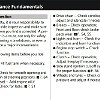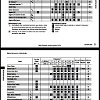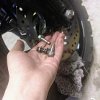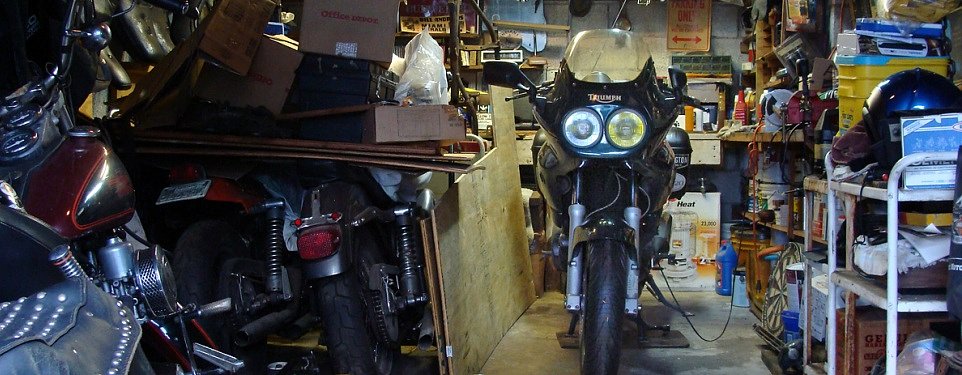I asked Stinky, my kid, to attend to his motorcycle service this year.
Stink rode through the winter. I wanted him to service his motorcycle based on its mileage. A spark plug woulda been nice. The drive chain certainly could have stood some attention. My son did none of these things. I was on crutches this winter, so I wasn’t out in the shop every day like normal, and upon finding the state of neglect his Grom was in, I became irascible.
I came to discover Stink’s negligence was a perfect opportunity for me to remember Hanlon’s Razor, but not until I bellowed at him for a few weeks. I think there are some lessons in here that apply to any beginner home mechanic (or an experienced mechanic mentoring a beginner), so let’s go through each of the problems he encountered in the course of owning his Grom, how they manifested themselves, and what (if anything) could have prevented them.
Problem One: Stink did not know what to do or when to do it
Stinky’s Grom was still running perfectly well, so there was little impetus for him to...well, to do anything at all, really.
I often hear novice mechanics lament that they don’t know what needs attention. Begin with the owner’s manual. Every owner’s manual has a section with a table describing exactly what service is required and the intervals at which it needs to be performed. Do not pass "GO." Do not collect $200. This chart is your bible.
So back in May, when I'd recovered enough from surgery to get my own bikes up and running, I checked the air pressure in all of the tires over the course of a few days. I’ve told Stink since he started riding to check ‘em at least every time he gets fuel, and I know good and well that lazy little so-and-so won’t do it. So I cornered the boy. I handed him a gauge and the air hose, and told him to check his tires.
Eight pounds. Eight. I went ballistic.

Read your owner’s manual. It will have a pre-ride checklist, as well as a maintenance chart. The pre-ride checklist is a pain in the ass, and because of that, I see most folks just skip right over it. The oldest riders on the oldest bikes are the folks who I think tend to stick to those lists pretty religiously… and they usually keep their junk running. All that time running hands and eyes over a motorcycle tends to ferret out problems long before they ruin rides. The pre-ride check is important because there are some specifications for which there simply is no acceptable "window" for deviation. Tire pressures are assumed to be correct every time the motorcycle is operated. Same with oil level. The only way to be sure that the machine is in spec for those items that have no operating deviation is to check them whenever the machine is operated!
Stink was coming up on 7,500 miles, which I briefly remembered was a big service for him. I recall telling him he’d need an oil change and a sparkin’ plug, and I vaguely recalled some internal filters I’d read about when I thumbed through his manual (on a bike I didn’t own!).

So a month went by, and still, a small red-headed man failed to hit me up for money for parts. I wasn’t asked for tools. I had this sneaking suspicion nothing was getting done. And finally, when I was alerted to how little air was in his tires, I was proven correct. I asked my boy if he’d tacked that maintenance table up on the wall of the shed where he is provided with a parking spot. I also asked if he’d read his service manual to find out about how to do his oil change.
Nope. This brings us to Problem Two. Before we continue on to Problem Two, however, know that we’ll be revisiting this problem of informational organization, which is carried through to Problem Three.
Problem Two: Stink remained obstinately ignorant
Hypothetically, dear reader, if your dad had a functioning motorcycle repair shop and was a somewhat able mechanic, and he told you to read a few manuals and you knew he was willing and able to help you in your mechanical conquests and ultimately you didn’t even pick up the manual, who is to blame when your bike goes kerflooey? Hypothetically.
I’ve written before about oldtimers pounding knowledge into my head. This is a tradition in motorcycling. It’s not just hazing, it’s an attempt to fundamentally change someone into being naturally inquisitive. Today, information almost couldn’t be easier to access. Hell, Stink’s service manual, which normally costs a hundred bucks, could be downloaded for free all over the internet. Same for the owner’s manual.
When it comes to workin’ on a motorcycle, eventually at some point or another. we all have just two choices if we want to keep the bike operable. You can take the bike to the dealer, drop it off, pay the mechanic, and move on with life. The other option is bypass the pro and save a few dollars doing stuff on your own. But that bypass is not easy if working on things and making them tick is not something you have experience with. You’ll pay with your money or pay with your time. Take your pick.
Back to my kid. By early June, Stink’s bike was still in disrepair. The chain was gunky and gross. I just bought him a new chain the previous season, and the boy didn’t scrub it or lube it even once. None of the maintenance has been performed. The bike was filthy. It had been hit in a parking lot, and my son has elected not to repair any of the damage — mostly because he didn’t even spot it.
So I told him to read up on how to check the internal engine filter and centrifugal oil spinner and determine what parts we might need. I also told him to pick up a spark plug.

A few days later, I start getting texts about brakes. My son disassembled his front caliper with no manual handy. I had little reason to believe the pads would need replacing. He told me he hadn’t ever changed the brakes on this motorcycle, and being a safety item, he thought he’d be responsible and take the bull by the horns.
At this point, I blew my stack again, and then realized that we were beyond the point of the boy being simply obstinate. It wasn’t a lack of effort so much as a deluge of information causing his inaction. I’ve told him before to do something. Anything but no thing. And he did. So we sat down for a little talk in the garage for some classroom work before we got to the hands-on training on how to repair the brakes and service the rest of the machine.
Problem Three, closely related to Problem One: Information is organized and categorized very clearly, but not intuitively
There is a logic to how the information on your machine is organized and ordered, but I realize that's not obvious to the beginner. There are two things I want to make clear about service and information organization.
First, any time you lift a wrench to work on your motorcycle, that is service. Service is a fork with two prongs: maintenance and repair. If you pick up a wrench because something is broken, that is repair. If you pick up your wrench so something does not break, that is maintenance. It is important to know the difference. Maintenance occurs when the manufacturer says you should do it. Repair occurs as needed.
Secondly, there are a number of places you can find information. Knowing where to find service information — some of it maintenance and some of it repair — and how it is organized is helpful.
Owner’s manual: This document has maintenance intervals and some specifications required for safe operation of the motorcycle, component location, as well as some general service requirements and perhaps some instructions on how to perform them.
Service manual: This book is the complete guide on how to disassemble and correctly reassemble every part of your motorcycle, and there are likely some tips on maintenance procedures, along with all the necessary operating specifications of the motorcycle. If you are working on your motorcycle, this is likely to be the book you spend the most time with.
Parts manual/catalog/fiche: This publication will have exploded diagrams of parts with visual indicators of how the parts are assembled. Part names and numbers will also be included.
Recalls: Recalls inform of potential safety defects. They can be furnished to you either by NHTSA or the manufacturer. It should be noted that the repair involved may well be the most affordable way to return a vehicle to safety, however, that repair may not be the most inexpensive solution (but an unsatisfactory repair) for a given problem or vehicle. That’s generally due to the fact that recalls are performed at the manufacturer’s cost, not the vehicle owner’s.
Technical Service Bulletins: Not to be confused with a recall, a TSB is a manufacturer’s advice on how to best repair an unforeseen problem that crops up often. It should be noted that there is no requirement or compulsion for a manufacturer to distribute these to owners. Sometimes it’s pulling teeth trying to get one, like when I wanted to dig in on Yamaha’s cam chain tensioner problems on the 900 triple. Other times, it’s so easy — for instance, Harley used to assemble all their TSBs for a model run into books called Shop Dopes, which are available for sale (and are often worth their weight in gold, in my opinion).
Now, of course, Problems One through Three were related, but Problem Four, which also posed Stink trouble, is a direct extension of the hurdles he’d already faced. Because Problem Four seems to cause a great big dichotomy, it caused me consternation as a parent, and made me feel like both an asshole and a hypocrite. And if I look in my rearview mirror, it caused me the same amount of trouble it did for Stink when I was his age.
Problem Four: All this information is arranged in a theoretical nature, but we live in a practical world
The manuals are great, but ultimately, as Stinky proved, they’re often worthless. Practical experience helps a hell of a lot, and in many cases is as important, if not more so, than the theoretical knowledge.

After our theory chat, we moved on to the practical portion of the class. I found he had disconnected the hydraulic brake line in order to check brake pad thickness. (This is not a necessary step.) I found brake pads that were improperly re-installed and actually fell out of place when I probed further to see what was wrong with the dad-gum things. I found a banjo bolt crush washer used as a normal washer under one (just one?) caliper retaining bolt. Yikes.
Stink received a lesson on banjo bolts, which was not found in the manual. We also talked about crush washers and their use, re-use, and lack thereof, also not found in a manual. We then had an impromptu lesson on brake bleeding (which was basically this video with more yelling). The manual does explain how to bleed brakes, but if you’re inexperienced enough to not be concerned with a bolt that suddenly leaks fluid, is “bleed brakes” jargon you’re likely to understand? Will you know when a brake needs a-bleedin’? Probably not.
Then we talked about brake pad inspection, which the manual covers. It doesn’t mention that if you stick your kisser under the caliper, you can see the wear limit groove pretty clearly without unbolting a damn thing, as the manual suggests. And that gunky chain? The manual told Stink, “Clean the chain with non-flammable or high flash point solvent and wipe it dry.” Stink dutifully attempted this by “scooching” his motorcycle all around the driveway while he scrubbed with the pot of kerosene.
Old Fat Dad told Stink that since the bike was far from mint, he was to lay it down on a few pieces of firewood from the wood crib and spin the wheel and chain and save some time.

Old Fat Dad overruled the manual. Old Fat Dad’s way was faster.
The manual also doesn’t tell Stinky the order in which items should be performed. For instance, after Stink followed the directions on changing the oil, he seemed ready to pour his fresh oil in the bike, just like the manual says. But the manual doesn’t mention that you might want to hold off on refilling the oil if you’re changing the internal spinner and filter, recommended on some service intervals with more intensive demands.
I could have let Stink figure that out the hard way. But wouldn’t that make me a turd, if I let Stink take his fresh quart of expensive Honda oil and allow him to have it leak all over the driveway after he removes his side cover? When I kept changing up the order of his plan, I think he thought I was just being a mean old fart. I am sure it appeared that there was no rhyme or reason to my hastily barked orders after I had just told him to blindly adhere to the service manual’s instructions.
Another “this is not pragmatic” problem came when it was time to inspect the spark plug. A spark plug’s cost is nearly nothing, just a few bucks. For the time we’ll take to pop it out, hell, let’s just put a new one in regardless of the shape of the old one. That idea would go double were he a paying customer. My hourly rate is too high for me to stuff a questionable spark plug back into a customer bike, so the customer will be buying a fresh one, like it or not. In this place, the “I” for “inspect” in the manual was edited by Old Fat Dad to an “R” for “replace,” and the rationale was explained.
Problem Four almost negates all the stuff I’ve already written. “If the books have all the information, Old Fat Dad, then am I supposed to just work in the shop with you forever to try and learn some of this crap?” Stink is too polite to ask me that directly, but I could practically feel the question emanating from him.
And I don’t have the answer.
Every piece of information one acquires, processes, synthesizes, and uses when assessing a new challenge makes all maintenance and repair easier. Practice really does move one nearer to perfection. For nearly everyone who hangs in there and does this long enough, there comes a time when one makes a tool or shortcuts a manual method and it works out great, and suddenly you are a genius. Then there’s other times where you try something and it goes terribly awry. When you wrench a lot, some days you’re the pigeon, and other days you’re the statue. This is why paying someone to work on your motorcycle often feels staggeringly expensive — this whole business is usually one big damn headache!
Stink made a number of mechanical mistakes. I made an equal or greater number of parenting and instructional missteps. This article is as much an acknowledgment of my own shortcomings as a mechanic and a father as it is a good case study to be turned into content for Common Tread reader consumption.
My hope is that this article, my self-administered penance, will allow me to achieve educational success where I recently failed. I also wish for it to highlight that no matter one’s skill level, each of us struggles, on the bike, off it, and away from it.














